Solar eclipse of February 5, 2046
An annular solar eclipse will occur on Monday, February 5, 2046. A solar eclipse occurs when the Moon passes between Earth and the Sun, thereby totally or partly obscuring the image of the Sun for a viewer on Earth. An annular solar eclipse occurs when the Moon's apparent diameter is smaller than the Sun's, blocking most of the Sun's light and causing the Sun to look like an annulus (ring). An annular eclipse appears as a partial eclipse over a region of the Earth thousands of kilometres wide.
| Solar eclipse of February 5, 2046 | |
|---|---|
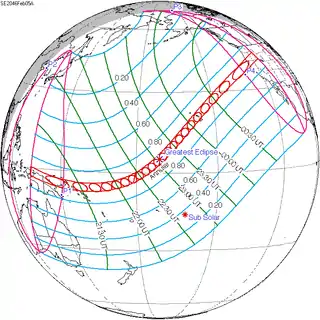 Map | |
| Type of eclipse | |
| Nature | Annular |
| Gamma | 0.3765 |
| Magnitude | 0.9232 |
| Maximum eclipse | |
| Duration | 582 sec (9 m 42 s) |
| Coordinates | 4.8°N 171.4°W |
| Max. width of band | 310 km (190 mi) |
| Times (UTC) | |
| Greatest eclipse | 23:06:26 |
| References | |
| Saros | 141 (25 of 70) |
| Catalog # (SE5000) | 9609 |
This is the next central solar eclipse whose path of totality or annularity passes over the U.S. state of Hawaii.
Images

Animated path
Related eclipses
Solar eclipses of 2044–2047
This eclipse is a member of a semester series. An eclipse in a semester series of solar eclipses repeats approximately every 177 days and 4 hours (a semester) at alternating nodes of the Moon's orbit.[1]
| Solar eclipse series sets from 2044–2047 | ||||||
|---|---|---|---|---|---|---|
| Ascending node | Descending node | |||||
| 121 | February 28, 2044 Annular |
126 | August 23, 2044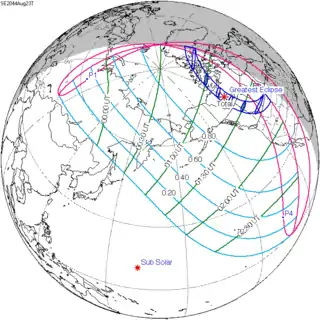 Total | |||
| 131 | February 16, 2045 Annular |
136 | August 12, 2045 Total | |||
| 141 | February 5, 2046 Annular |
146 | August 2, 2046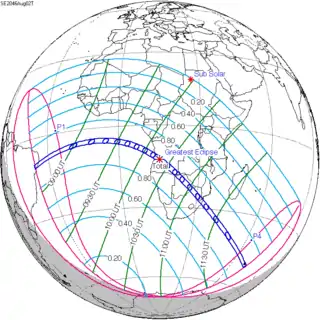 Total | |||
| 151 | January 26, 2047 Partial |
156 | July 22, 2047 Partial | |||
| Partial solar eclipses on June 23, 2047 and December 16, 2047 occur on the next lunar year eclipse set. | ||||||
Saros 141
Solar saros 141, repeating every about 18 years, 11 days, and 8 hours, contains 70 events. The series started with partial solar eclipse on May 19, 1613. It contains 41 annular eclipses from August 4, 1739, to October 14, 2460. There are no total eclipses in this series. The series ends at member 70 as a partial eclipse on June 13, 2857. The longest annular eclipse occurred on December 14, 1955, with maximum duration of annularity at 12 minutes and 9 seconds. All eclipses in this series occur at the Moon’s ascending node.[2]
| Series members 17–36 occur between 1901 and 2259 | ||
|---|---|---|
| 17 | 18 | 19 |
 November 11, 1901 |
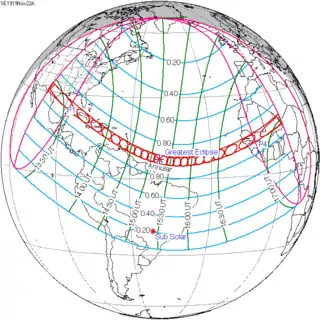 November 22, 1919 |
 December 2, 1937 |
| 20 | 21 | 22 |
 December 14, 1955 |
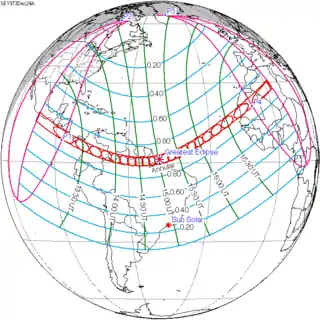 December 24, 1973 |
 January 4, 1992 |
| 23 | 24 | 25 |
 January 15, 2010 |
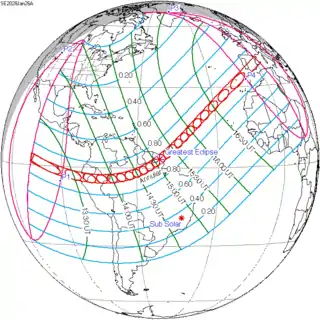 January 26, 2028 |
 February 5, 2046 |
| 26 | 27 | 28 |
 February 17, 2064 |
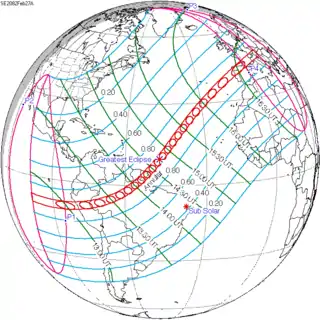 February 27, 2082 |
 March 10, 2100 |
| 29 | 30 | 31 |
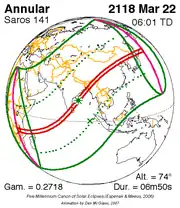 March 22, 2118 |
 April 1, 2136 |
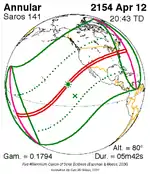 April 12, 2154 |
| 32 | 33 | 34 |
 April 23, 2172 |
 May 4, 2190 |
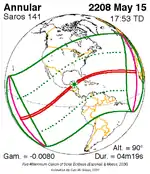 May 15, 2208 |
| 35 | 36 | |
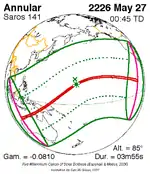 May 27, 2226 |
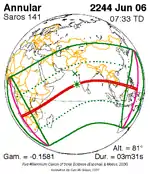 June 6, 2244 | |
Inex series
This eclipse is a part of the long period inex cycle, repeating at alternating nodes, every 358 synodic months (≈ 10,571.95 days, or 29 years minus 20 days). Their appearance and longitude are irregular due to a lack of synchronization with the anomalistic month (period of perigee). However, groupings of 3 inex cycles (≈ 87 years minus 2 months) comes close (≈ 1,151.02 anomalistic months), so eclipses are similar in these groupings.
| Inex series members between 1901 and 2100: | ||
|---|---|---|
 May 18, 1901 (Saros 136) |
 April 28, 1930 (Saros 137) |
 April 8, 1959 (Saros 138) |
 March 18, 1988 (Saros 139) |
 February 26, 2017 (Saros 140) |
 February 5, 2046 (Saros 141) |
 January 16, 2075 (Saros 142) |
||
Metonic series
The metonic series repeats eclipses every 19 years (6939.69 days), lasting about 5 cycles. Eclipses occur in nearly the same calendar date. In addition, the octon subseries repeats 1/5 of that or every 3.8 years (1387.94 days). All eclipses in this table occur at the Moon's ascending node.
| 21 eclipse events, progressing from south to north between July 1, 2000 and July 1, 2076 | ||||
|---|---|---|---|---|
| July 1–2 | April 19–20 | February 5–7 | November 24–25 | September 12–13 |
| 117 | 119 | 121 | 123 | 125 |
 July 1, 2000 |
 April 19, 2004 |
 February 7, 2008 |
 November 25, 2011 |
 September 13, 2015 |
| 127 | 129 | 131 | 133 | 135 |
 July 2, 2019 |
 April 20, 2023 |
 February 6, 2027 |
 November 25, 2030 |
 September 12, 2034 |
| 137 | 139 | 141 | 143 | 145 |
 July 2, 2038 |
 April 20, 2042 |
 February 5, 2046 |
 November 25, 2049 |
 September 12, 2053 |
| 147 | 149 | 151 | 153 | 155 |
 July 1, 2057 |
 April 20, 2061 |
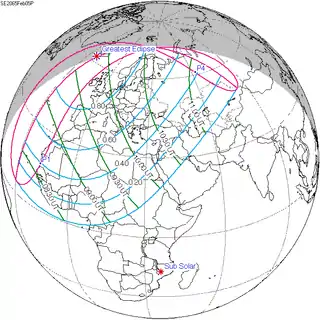 February 5, 2065 |
 November 24, 2068 |
 September 12, 2072 |
| 157 | 159 | 161 | 163 | 165 |
 July 1, 2076 |
||||
Tritos series
This eclipse is a part of a tritos cycle, repeating at alternating nodes every 135 synodic months (≈ 3986.63 days, or 11 years minus 1 month). Their appearance and longitude are irregular due to a lack of synchronization with the anomalistic month (period of perigee), but groupings of 3 tritos cycles (≈ 33 years minus 3 months) come close (≈ 434.044 anomalistic months), so eclipses are similar in these groupings.
| Series members between 1801 and 2100 | |||
|---|---|---|---|
 December 21, 1805 (Saros 119) |
 November 19, 1816 (Saros 120) |
 October 20, 1827 (Saros 121) | |
 September 18, 1838 (Saros 122) |
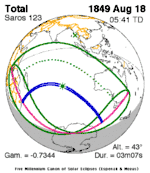 August 18, 1849 (Saros 123) |
 July 18, 1860 (Saros 124) | |
 June 18, 1871 (Saros 125) |
 May 17, 1882 (Saros 126) |
 April 16, 1893 (Saros 127) | |
 March 17, 1904 (Saros 128) |
 February 14, 1915 (Saros 129) |
 January 14, 1926 (Saros 130) | |
 December 13, 1936 (Saros 131) |
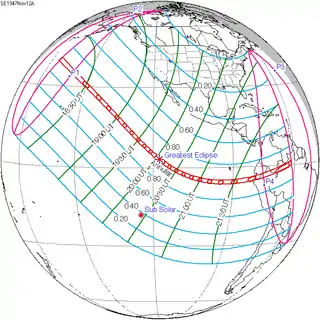 November 12, 1947 (Saros 132) |
 October 12, 1958 (Saros 133) | |
 September 11, 1969 (Saros 134) |
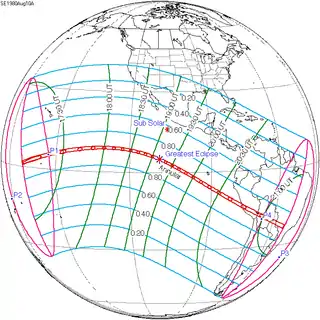 August 10, 1980 (Saros 135) |
 July 11, 1991 (Saros 136) | |
 June 10, 2002 (Saros 137) |
 May 10, 2013 (Saros 138) |
 April 8, 2024 (Saros 139) | |
 March 9, 2035 (Saros 140) |
 February 5, 2046 (Saros 141) |
 January 5, 2057 (Saros 142) | |
 December 6, 2067 (Saros 143) |
 November 4, 2078 (Saros 144) |
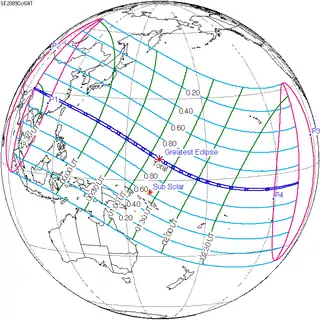 October 4, 2089 (Saros 145) | |
 September 4, 2100 (Saros 146) |
|||
In the 22nd century:
- Solar saros 147: annular solar eclipse of August 4, 2111
- Solar saros 148: total solar eclipse of July 4, 2122
- Solar saros 149: total solar eclipse of June 3, 2133
- Solar saros 150: annular solar eclipse of May 3, 2144
- Solar saros 151: annular solar eclipse of April 2, 2155
- Solar saros 152: total solar eclipse of March 2, 2166
- Solar saros 153: annular solar eclipse of January 29, 2177
- Solar saros 154: annular solar eclipse of December 29, 2187
- Solar saros 155: total solar eclipse of November 28, 2198
In the 23rd century:
- Solar saros 156: annular solar eclipse of October 29, 2209
- Solar saros 157: annular solar eclipse of September 27, 2220
- Solar saros 158: total solar eclipse of August 28, 2231
- Solar saros 159: partial solar eclipse of July 28, 2242
- Solar saros 160: partial solar eclipse of June 26, 2253
- Solar saros 161: partial solar eclipse of May 26, 2264
- Solar saros 162: partial solar eclipse of April 26, 2275
- Solar saros 163: partial solar eclipse of March 25, 2286
- Solar saros 164: partial solar eclipse of February 22, 2297
References
- van Gent, R.H. "Solar- and Lunar-Eclipse Predictions from Antiquity to the Present". A Catalogue of Eclipse Cycles. Utrecht University. Retrieved 6 October 2018.
- Saros Series Catalog of Solar Eclipses NASA Eclipse Web Site.
External links
- Earth visibility chart and eclipse statistics Eclipse Predictions by Fred Espenak, NASA/GSFC
.jpg.webp)

